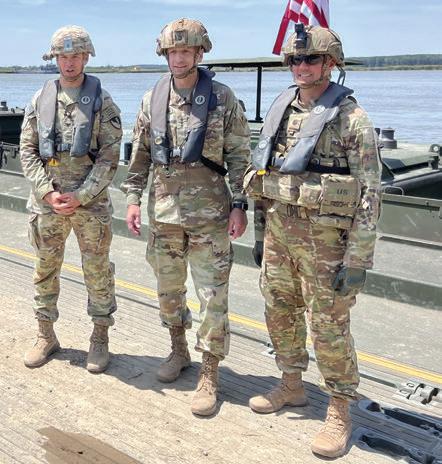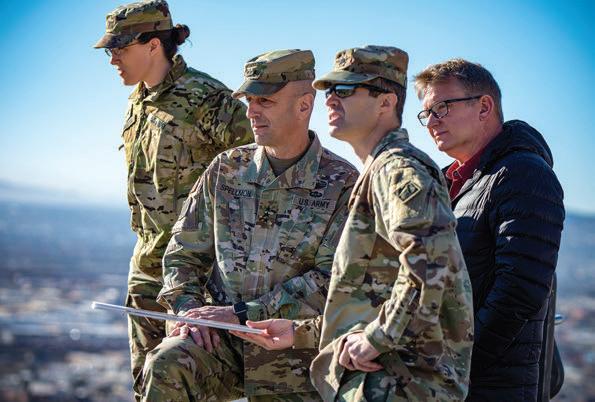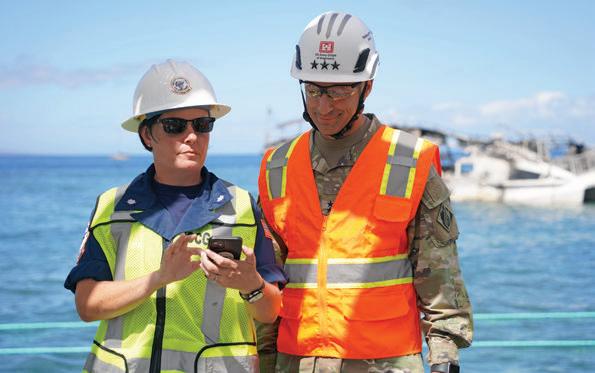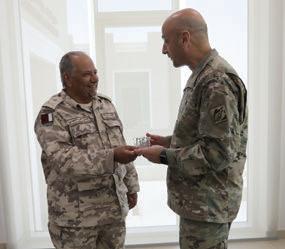
16 minute read
Interview: Lt. Gen. Scott A. Spellmon, Commanding General and Chief of Engineers
BY CHRISTOPHER J. AUGSBURGER, USACE HEADQUARTERS
Lt. Gen. Scott A. Spellmon assumed duties as the 55th chief of engineers and commanding general of the U.S. Army Corps of Engineers (USACE) on Sept. 10, 2020, after most recently serving as the USACE deputy commanding general for civil and emergency operations.
Spellmon, a native of Bloomingdale, New Jersey, is a 1986 graduate of the U.S. Military Academy at West Point, New York. He holds a Master of Science in civil engineering from the University of Illinois at Champaign/Urbana and a Master of Science in national security strategy from the U.S. Army War College.

Spellmon’s command assignments include commanding general of USACE’s Northwestern Division, where he oversaw an annual program of more than $3 billion in civil works, environmental restoration, and military construction in 14 states, primarily within the Columbia and Missouri River basins; commanding general of the U.S. Army Operational Test Command, Fort Hood, Texas; commander, 1st Maneuver Enhancement Brigade, Fort Polk, Louisiana; commander, 317th Engineer Battalion and 3-3rd Brigade Special Troops Battalion, both as part of the 3rd Brigade Combat Team, 3rd Infantry Division at Fort Benning, Georgia.
Spellmon’s key staff assignments include executive director, Office of the Chief of Engineers, Headquarters, Department of the Army; chief of staff, U.S. Army Maneuver Support Center of Excellence, Fort Leonard Wood, Missouri; engineer intelligence officer, Allied Command Europe Rapid Reaction Corps, Rheindahlen, Germany; and observer-controller, Combat Maneuver Training Center, Hohenfels, Germany.

Spellmon’s operational deployments include Operation Desert Shield/Desert Storm; Operation Iraqi Freedom; and Operation Enduring Freedom, Afghanistan. His military awards and decorations include the Distinguished Service Medal, Legion of Merit, two Bronze Stars, the Purple Heart, and the Combat Action Badge.
What will be your No. 1 priority going into your final year in command?
Lt. Gen. Scott A. Spellmon: As I look toward my final year in command of this incredible organization, my No. 1 priority remains safely delivering quality projects on time and within budget.
I see this happening through an approach that focuses on the idea of “thinking di fferently” across everything we do so that our solutions represent a multitude of cultures, disciplines, scientific approaches, and skills. This diversity of thoughts and skills will better advance our efforts on innovation, how we do business, and how we continue taking care of our most important resource – our people.
But thinking differently goes far beyond the mere demographics of an organization. We can only strengthen our abilities and become more agile when we welcome, encourage, and develop fresh ideas and new perspectives from across the enterprise. From exploring new ways to monitor projects to uncovering yet-to-be-developed technologies, “thinking differently” will enable us to successfully deliver the more than $91 billion in work that lays ahead for USACE.

One key part of thinking differently is deepening our relationships with our partners. In this next year, I’d like to build upon the successful partnership initiatives of the last three years – such as the publication of a construction partnering playbook; the Partnership Philosophy to guide our relationships across the enterprise; and the partnership charter with the Association of General Contractors of America – and put more ideas into action.
Our efforts are beginning to show real results. In fact, in October [2022] we were honored to receive the National Academy of Construction’s Recognition of Special Achievement award for our Fargo-Moorhead Metropolitan Area Flood Risk Management Project. This project is a massive effort to reduce the risk of flooding to more than 260,000 people. The project consists of multiple components that are being designed and constructed simultaneously across two states by our partner entities using a process called “split delivery.” When complete, it will provide permanent flood risk reduction measures to more than 260,000 people. Thanks to this unique shared delivery method, we’re on track to complete this project 10 years sooner than if the project was delivered using traditional approaches.

In addition, the project is also using a Public-Private-Partnership, or P3, to deliver the project’s 30-mile-long diversion channel and associated infrastructure. The P3 is a first in the history of the U.S. Army Corps of Engineers. In these innovative ways, the Fargo-Moorhead region is establishing a new paradigm that can potentially be used elsewhere to construct large projects faster and at a lower cost to taxpayers.
We recognize that the traditional way of delivering through in-house design and design-bid-build contracts may not meet the expectations of our stakeholders. We anticipate contracting out more design work and increasing our use of design-build and other alternative delivery methods [ADM] contract vehicles, but we will not do this in a vacuum and need industry’s feedback during acquisition planning stages to help shape favorable outcomes.
These new activities exemplify the positive changes that can occur when we listen to our partners and open our aperture for thinking di fferently. This approach leverages the talents and skills that industry can bring to our projects early, often, and throughout the life of a project.
But partnering is more than a series of discreet events that take place during the construction phase of a project. It is a mindset which embodies a set of behaviors that shape how we interact with each other and our stakeholders.
From a technology perspective, I want to build on an extremely productive past year. This year, we released our first-ever research and development strategy, with 10 priorities focused across the globe supporting our warfighters, our citizens, and the environment. And in March, the president requested $86 million for research and development [R&D] in his fiscal 2024 budget request, plus an additional $16 million of associated R&D activities across our business lines. This further demonstrates a commitment to invest in science and innovation that will deliver enduring solutions for water resources and other infrastructure and environmental challenges.
This level of investment comes at a critical time. Extreme weather events in recent months – including the summer wildfires in Hawai’i and recent hurricanes in California and Florida – demonstrate the urgent need for advancements in R&D.

In California, for example, we are moving forward with Forecast Informed Reservoir Operations [FIRO]. This technology allows us to accurately predict and plan for the amount of water an atmospheric river will drop on a particular area. Working closely with NOAA and the U.S. Air Force, we are now poised to complete the first water control manuals that incorporate FIRO into reservoir operations. This is a significant leap forward in the operation of important infrastructure projects in the West, and another example of putting innovation into action.
What remains the biggest challenge facing USACE?
Our workload remains our greatest challenge and our greatest opportunity.
This time last year, we had just embarked on one of the most historic missions in our 248-year history in terms of funding levels. Between our normal civil works appropriations, emergency supplemental appropriations, the 2021 passing of the Bipartisan Infrastructure Law, and our normal yet massive Military, Interagency, and International efforts around the globe, we were facing a program that had grown to more than $92 billion. Since then, we’ve seen even more growth as we responded to the devastation in Guam from Typhoon Mawar in May, wildfires in Hawai’i in August, and the effects from Hurricane Idalia in Florida. We continue to provide support to communities impacted from a variety of extreme weather events around the country.

With tough challenges come innovative solutions, and our team has worked to address these challenges to bring on more talent. It all starts with people! We have 38,500 professionals — our largest workforce in more than two decades — stationed in 39 countries working on projects in 110 countries. The men and women of the U.S. Army Corps of Engineers and the Engineer Regiment have served our nation extremely well, and we owe them the best training, the best education, and the best technology, so they can stand up and deliver on their full potential.
I remain laser-focused on continuing to find new ways to hire and keep our country’s best and brightest. I’m very proud of the work we’ve done to continue to engage underrepresented communities across the nation. Just last year, we signed a Memorandum of Agreement with the American Indian Science and Engineering Society, which provides Native American students with formal access to Army science, technology, engineering, and math jobs and educational opportunities. These are important e fforts that we are very proud of, but it’s just the beginning. We know we can and must do more. Our human capital professionals are closely linked with every business line of our organization, hosting more job fairs – both in-person and virtual – and empowered to provide on-the-spot job offers. We’re reaching out to more colleges and universities than ever before, and we continue to improve how we recruit from within so that we develop and retain the right talent.

We are already seeing the results of these efforts. Our current strength is higher than our end of fiscal year strength for every year since 1996! In the past year alone, we’ve increased our onboard personnel by 1,300 (3.5%).
Bringing people onto the team is only half the battle; we must ensure they have the tools needed to succeed. So, we are continuing to transform our organization and decision-making processes to safely deliver this historic program while finishing quality projects on time, within budget, and doing it safely.
As we draw closer to the Army of 2030, what is one innovation within the Engineer Regiment that you’d like to highlight?
We are approaching the most significant Army transformation since the end of the Cold War. To maintain a military advantage over adversaries, we must leverage and exploit new technologies across all domains.
A key focus for Army 2030 is preparing for multidomain operations to provide decisive effects for the Joint Force. We know that forward-positioned ground forces — able to converge effects from land, air, sea, space, and cyberspace — complicate our adversaries’ decision-making, disrupt their actions, and assure our allies and partners.

This is one main reason why I say that our geospatial capabilities are foundational and at the leading edge of this overall multidomain transformation effort.
Our Army geospatial engineers possess unique tools, skills, and expertise to help commanders understand, visualize, analyze, and describe the terrain and its impacts on multidomain operations.
That’s why I’m incredibly excited to deliver the “Army Geo Data Fabric” [AGDF] architecture. The AGDF is a collaborative partnership across the Army and the intelligence community that provides the first enterprise geospatial infrastructure for the Army. Currently operational, the AGDF will continue to expand capability and functionality to provide the authoritative geospatial foundation across all domains and provide the geospatial underpinning for joint all-domain command & control, and multi-domain operations.
Our team is focused on delivering these capabilities for the warfighter as elements of the AGDF. We will also continue to leverage the expertise of our talented USACE teammates in the Army Geospatial Center, the Geospatial Research Laboratory, and the Engineer Research and Development Center to maintain geospatial modernity with an eye on 2030 and beyond. Each of these organizations possesses essential tools, data, and expertise to support our forward-deployed units as they modernize to address future needs.
As we move forward, we constantly look outward to expand the collaboration between the Army Geospatial Center and the geospatial intelligence community to modernize the delivery of content-managed, authoritative Army geospatial data and geospatial intelligence software.
While a huge portion of the USACE mission is executed right here in the United States, there are amazing things being accomplished overseas that support our nation and our national defense objectives. What are some of these more unique aspects and capabilities within the USACE mission and why are they important?
We have USACE teammates overseas supporting each of our nation’s combatant commands, and each project is immensely important. Let me highlight just a few recent examples that show the value and breadth of our overseas efforts.
Since 2010, many of our projects directly support military families through the Department of Defense Education Activity, or DODEA. We’ve partnered with them on projects at home and around the world to help deliver on their 21st Century Schools i nitiative. Through this program, we’ve delivered 40 brand-new schools – 18 in the Americas, 12 in the Pacific, and 10 in Europe, with still more schools on the way. We’re also delivering playgrounds, laboratories, furniture, and any other elements our teachers and administrators require to provide worldclass learning facilities for our warfighter families today and into the future.
In the Atlantic, we’re working with allies and partners on an array of projects that contribute to the European Deterrence Initiative, the NATO Security Investment Program, and Foreign Military Sales cases. Projects in Eastern Europe, particularly in Poland, Romania, Bulgaria, and the Baltics, delivered during the past several years, are playing a key role in strengthening NATO, reassuring our allies, contributing to readiness, developing capacity, improving interoperability, and deterring aggression.
These projects range from helping field integrated weapons systems and improving runways to upgrading base infrastructure, training ranges, and facilities that benefit not only U.S. forces but our partners and allies.
USACE is also managing a more than $400 million investment in the modernization of Army Prepositioned Stock sites throughout western Europe.
To support potential deployments, we’re helping deliver the Operational Readiness Training Complex [ORTC] construction program in Grafenwoehr, Germany. Over the course of decades, the long-term concept is for three ORTCs to be delivered, with each ORTC including all the necessary facilities and infrastructure for a full brigade set of Soldiers and equipment. Our Europe District team recently broke ground on the first of several projects in support of this effort, marking the beginning of construction on the first phase of the $1.7 billion ORTC being built there.
In the U.S. Central Command’s [USCENTCOM] area of responsibility, we provide oversight of more than $5 billion in projects by combining dedicated and expeditionary district capabilities to deliver innovative, resilient, and sustainable solutions to the U.S. Department of Defense, USCENTCOM component commands, and the U.S. Special Operations Command.

With a legacy of more than 70 years in the region, we deliver our program through two districts; the Transatlantic Middle East District, headquartered in Virginia, and the Transatlantic Expeditionary District – USACE’s only forward-deployed district, a tailored command that merges the Transatlantic Division’s contingency and design and construction capabilities – poised to effectively fulfill both the immediate operational demands and the long-term infrastructural needs of the region.
Our mission in the region encompasses more than simply building infrastructure; it’s about creating strategic capabilities and enhancing force protection measures that underpin military readiness and operational flexibility. From missile defense infrastructure, airfields, and hangars, to clinics and housing critical to our U.S. service members’ quality of life, we continue to provide engineering and construction solutions in one of the most dynamic construction environments in the world. Our work is foundational to the success of USCENTCOM’s initiatives.

Through the Middle East and Expeditionary Districts, we offer a comprehensive suite of engineering, design and construction services that reflect our core principles of trust, resilience, innovation, and readiness. Our multifaceted efforts ensure that we are not just responsive to current needs but are also proactively shaping the operational landscape for the future.
This dedicated approach cements our role as a key partner within the US - CENTCOM AOR, where our contributions significantly impact the collective security and strategic capabilities of the region’s forces. The Transatlantic Division’s enduring commitment to excellence and partnership underscores our pivotal position in supporting the overarching mission of USCENTCOM
In the Indo-Pacific, we design and construct facilities for the Army and Air Force in Alaska and Hawaii and for all Department of Defense agencies in Korea, Japan, and Kwajalein. Our largest workload in the region is our host-nation program where we design and help construct facilities for all U.S. forces in Korea and Japan, including over $22 billion in host-nation construction to date, with $6 billion in host-nation planning, design, and construction underway.
In Korea, our team helped complete a timely $22 million runway repair at Kunsan Air Base, allowing full aircraft mission capability to resume at this critical base. We are also nearing completion of a $135 million Housing Tower Complex at Camp Humphreys, providing 216 homes to active-duty families, and a $15 million chapel at Osan Air Base.
In Japan, our team helped complete over $30 million in infrastructure repairs across Japan bases, and we are nearing completion of an $8 million postal distribution center on Camp Foster, providing much-needed mailing capacity to distribute mail to bases island-wide.
Additionally, USACE deploys Forward Engineer Support Teams [FESTs] throughout the region in support of the INDOPACOM commander’s “To Be” vision for posture to deter regional adversaries. The 34th FEST is currently in the Philippines, conducting project surveys with the Philippine army and navy for airfields, training areas, explosive storage facilities, and road improvements.
We continue to go to great lengths to ensure that we apply the diverse array of talents – and thoughts – throughout USACE and the Engineer Regiment, at home and abroad.










